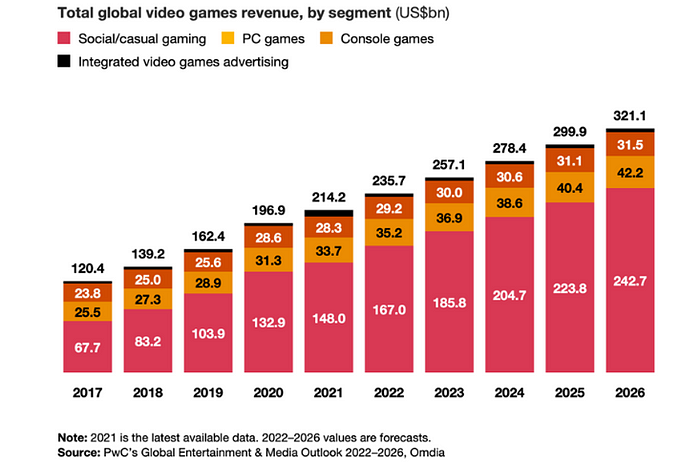Play-to-Own Won’t Cut It
Opinion piece by David
After the dramatic fall of everything Play-to-Earn, many have switched their thesis to the so-called Play-to-Own design. Here is why we’ve gone a different route with Stumble upon Rumble.

Crypto Gaming in General
I believe crypto gaming will once again be one of the top performing sectors within crypto. Gaming on its own is one of the most steadily and fastest growing sectors with a CAGR over 13%. Combined with crypto this creates a combination of two of the fastest growing industries, and this combination is still a blue ocean without market leaders.
In addition to that, it speaks to the target audience. Everyone knows games and the internet-native crypto demographic has an even larger overlap with gamers. Games have the edge of being fun and being strong dopamine sources which naturally draws more people to them, especially with the prospect of even more dopamine through making money and rising prices.
Lastly, it’s been one of the most well-funded sub-sectors of crypto. It now has a lot of teams incentivised to market and increase awareness of it, which has strong externalities for the entire sector.

Why did Play-to-Earn die
We all remember the beautiful period after Axie’s breakthrough where Play-to-Earn was the hottest narrative around. Never before had we seen such a large group of people making a living by playing video games. What followed was a long list of Play-to-Earn games, each with a nearly identical token economy.
Prices were up and people were printing free money from these games, or so they thought.
In reality, the speculation of crypto investors buying these tokens and game assets was the only thing that was offsetting the token inflation needed to provide the rewards. When there were less buyers stepping in and crypto sentiment went down in general, so did the prices and earnings.

What is Play-to-Own
Play-to-Own is the new model in town. It is much less focused on the crypto elements and only involves the technology in minor ways. Instead of buying a game asset that’s tied to your game account, you now buy a game asset that is minted as an NFT to your wallet. It’s just like current games, except with more ownership for players.
It’s a very safe model to apply and to promote. It doesn’t take the same level of economic planning to add this to a game, and the chances of this tanking an in-game economy are rather small. Some of the biggest and most hyped crypto games are taking this approach, games like Blankos, Big Time, and Embersword. It makes sense for them to apply this less risky model due to the large scope of their games.
Bearish Play-to-Own
There are four main reasons why I don’t believe Play-to-Own is the way:
- 1. NFT-hatred
I know, it’s baseless. But the fact is that a large group of people, especially gamers, hate NFTs with passion. They hate the stupidity and irrationality about NFTs shown in the news (like Bored Ape pictures selling for $400k), they hate the people representing it, and finally they have many uninformed but strong views on things like environmental impact and IP theft. Making your unique selling point just about NFT ownership won’t help. - 2. People do not care
Even the people that do not hate NFTs care so little about it. It’s more of a nice-to-have feature, but far from a selling point to convince them to play your game. - 3. Less profitable
While the additional benefit to the user is small, the impact for Game Studios is huge. They lose their monopoly position of the in-game markets. Players can now buy recycled items from each other instead of buying everything new from the studio. - 4. Lack of Attention
Finally, the most important point. The highest returns come from bull markets, when money and interest are peaking. But this is also the time when there is a lot of noise and competition around the attention of the market participants. As a safe and ‘boring’ game economy it will be difficult to get noticed over the hot Play-to-Earn games that will pop off left and right, each with the (perhaps false) promise of high returns. This leads to a lack of attention towards Play-to-Own games right around the time when you want and need the attention the most.
Simply put, Play-to-Own has a lot of downsides without any of the speculative upside that comes from crypto-focused products. This makes the odds of complete virality and/or parabolic appreciation of your investment much less likely.
Thesis: Crypto-focused Games
So then what kind of games will we see thriving?
The past is the best way to predict the future. When sentiment and attention shifts back to the crypto markets en masse, market participants are drawn to the things that make them money. They flock to meme coins, hyped up ICOs, and as we have seen Play-to-Earn games. Ideally with loud and wild claims of profitability.
The games that will then garner the most attention, will be the ones proudly parading their crypto-native features and financial aspects. People won’t mind going through and learning about the complexities if they believe it’s going to make them money. Because indie teams with smaller/simpler games can more easily take the risk of applying these models, I believe indie games will lead the way.

Short Term & Long Term
Isn’t this just a short-term, predatory thesis then? Profiting off of Play-to-Earn before it collapses again? Well, yes and no.
Yes, there will be many games applying the same type of models when the market is good again. And yes, these will probably perform very well for as long as the great market lasts, after which they eventually collapse.
But there are also longer-term bets out there of games that are crypto and financially focused without risking the implosion of their economy. These are games that are willing to innovate and apply different, more sustainable methods, without taking away the crypto and financial aspects. For example, games featuring betting against other players, dynamic rewards based on total in-game activity (which helps curb the inflation), and real-revenue backed rewards through ads, cosmetic sales or other forms of in-game revenue.
These are the games that can draw in the most people when times are good, but still retain them without dying when times become worse.
Stumble upon Rumble
I put my money where my mouth is with Stumble upon Rumble, where we don’t beat around the bush with our crypto functionality.
We try to be one of the teams innovating with sustainable ways to make highly crypto centered games. We do this through financializing aspects of the game with in-game betting, staking tokens behind other players, rewarded participation events, and more.
Let’s see how it plays out!

